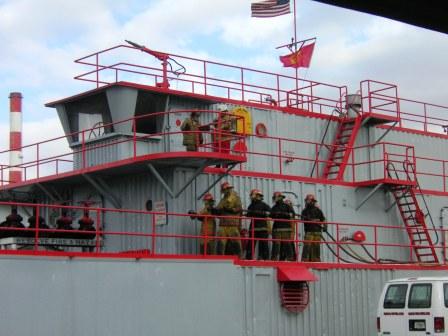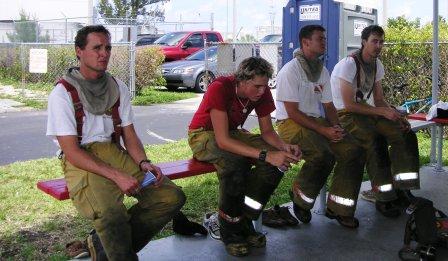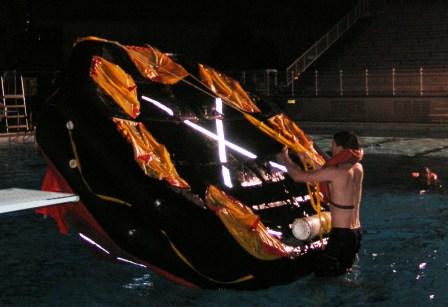MOB
Recently on SA there have been postings regarding MOB situations. I am by no means and expert on the situation. I have spent considerable amount of money in the last year on safety equipment of my own which I take with me when ever I go offshore. I am not suggesting that everyone should do this it simply the precautions I take as I am in the position of sailing on many different boats and with many different crew. I have also generally been one of the most experienced people on the boat and am therefore someone who rightly or wrongly is asked to take command of a situation. This is worrying as I am as likely if not more likely to be the person who falls off the boat due to the nature of my activity onboard. So although it is bulky I have started to wear a bum bag around my waist when the conditions warrant in this bag is the following:
1)VHF
2)GPS
3)Personal EPIRB
4)Laser Flare
The theory is that if I go over and am conscious I will be able to communicate my position via VHF to the boat and will be able to communicate my distress via EPIRB and show my position using the laser flare. Lets hope I never have to use it
Running Rigging for Offshore Sailing
Rig prep before a long offshore can make or break your race.
1) Pull the rig and fully check all fittings and also sheaves for sharp edges
2) If you don’t have all line halyards install them – get rid of the wire rope halyards although they are cheaper they are not as light as wire and aren’t as flex resistant. High tech line is the way to go and you can save more weight by tapering them and make sure your rigger put spectra chafe gear where the halyard sits on the sheave.
3) What type of race is this? Upwind add in a spare jib sheet you can also use for change sheet. Downwind have a spare guy and chafe gear where the guy goes through the end of the pole. Carry an extra halyard and make all lines extra long so that in case of bad chafe you can resplice a few times.
MASTHEAD: The 2 most common masthead setups for spin halyards are externally hung blocks off of U-bolts, or a “Tri-sec†type where the halyards exit straight off the sheaves over chafe bars or rollers.
If you have externally hung blocks, make sure the bracket that extends them out from the masthead goes far enough to allow the blocks to swing well clear of the headstay or anything else. Also check the wear at the interface of the U-bolt and the block shackle. These often tend to saw through each other. It is becoming very popular to use spectra webbing or lashing here instead of shackles. Many wraps of spectra can be incredibly strong, light, and can flex forever. Make sure that there are no sharp metal edges touching the line.
For a tri-sec style masthead, if you had wire halyards get rid of them (more on this later). These mastheads are fine as long as the chafe bars or rollers have enough smooth surface area for the rope to bend around and spread the load out. Install new rollers if needed.
Make sure you have 2 spin halyards. It is customary to run at least one spin halyard external for these downwind races. The extra windage won’t hurt off the wind. I prefer not to run more than one external to avoid having too much line flopping around.
AFTERGUYS: The afterguys take a lot of wear at the pole tip so one thing to check is the pole ends. For boats over 35’ or so I highly recommend an offshore style pole end with a lot of bearing area for the rope. For the guy itself it is hard to beat single braid spectra for its wear and flex life. Use a heavy “donut†to keep the shackle from messing the pole end or getting stuck. On larger boats you may need an aluminum donut that won’t split under high load. Svendsens makes a high load aluminum donut for boats over 50 feet.
SHACKLES: For both the spin sheet and the guys use large bail shackles. These bear on the donuts better and allow enough room to hook the guy into the sheet shackle bail. Use “internal release†style shackles that can be spiked open under load and also have less of a tendency to “flog offâ€. Use spectra chafe guard in high chafe areas i.e. where a halyard goes over a sheave or through a jockey or spinnaker pole.
If you have a jib furler, remember to keep the spin halyards out of the way. Flip them behind the shrouds when not in use. One good “halyard wrap†and a halyard can be messed up good.
JIBSHEETS: Go for a line with a high tech core. Dacron is too stretchy for jibsheets unless you want to constantly adjust them for every puff and wave. For Bay racing jibsheet shackles are nice for tacking, but for ocean sailing bowlines are fine.
Line fiber types
SPECTRA: Best flex life. Very slippery so also great for chafe. Very low stretch under oscillating loads. Problem: Under steady high loads, spectra “creeps†or gets slowly longer. Usually not the greatest for main and jib halyards.
TECHNORA: Very strong and low stretch, with little or no creep. Does not have the flex life of spectra and should be protected from the sun. Great for main and jib halyards.
VECTRAN: Also very strong and low stretch, with little or no creep. A little better flex life than technora but not near that of spectra. Great for main, jib and universal (combo jib & spin) halyards. Rather expensive.
X40 Sailing on the Bay
Today I went out on iShares Xtreme 40 which Hugh Styles is skippering. Hugh and I worked together on Yeoman XXXII last year and when he was asked to bring the X40 to the Bay he called Racing Yacht Management to help out with some of the logistics.
The boat arrived in a 40 foot container at the end of February – the hulls mast etc all fits onto a trailer which goes in the container. There is about 2 inches on all sides. The crew built the boat last week over at Svendsens only needing a crane to put the mast up and launch the boat.

The boat is sponsored by iShares and Hugh has been hired on as skipper see http://www.hughstyles.com/home
I really enjoyed my little sail around the bay. The boat is very fast and when you start flying the hull it is a cool feeling. You can tell that there is a fine line and it can all go tits up very quickly. It was a perfect sunny day on the bay blowing 20-25 knots and we were going the same speed as the wind. I was glad to have my Kokotat drysuit on as although it wasn’t that wet it was cold.
After lunch with the guys at the club of soup to warm the cockles of Hugh’s heart, I took them all to sports basement as they needed thermals. They hadn’t heeded my warning about the temperature at this time of year.
See video below of the boat sailing.
[youtube CHKOK_wNVoQ]
The Killing Fields
24th March – I pretty much snapped this morning and told Annabelle that we were upgrading from the $1.50/night room on the lake to a new place with air conditioning. I just couldn’t deal with sweating profusely while trying to sleep in a dirty room. So I dragged her to a new place with air conditioning, clean sheets and a TV all for the very expensive $13/night.
After checking into our new place our driver took us to the Genocide Museum S21 it is very horrifying we went from there onto the Killing Fields at Choeung Ek before moving on from there we sat at a table in the shade. The sheer horror of what we had seen made for a very quite day. It is amazing the cruelty that human beings are capable of. I didn’t like how they tried to portray the tragic events as being more horrifying than the Holocaust in Nazi Germany. In my mind both regimes were horrendous and they don’t need to be compared to make them anymore so.

Annabelle and I have been reading a few books by people who survived the Khmer Rouge – Stay Alive My Son is very good. At the moment I am reading The Gate by Francois Bizot one of the only Westerners to survive the Khmer Rouge.
We went back into town for lunch at Friends a resturant run by former street children. The food was delicous it was though western level pricing. Then onto the National Museum which had every type of carved Budda possible I must admit though that we had pretty much had our fill of temples and statues! Onto the Russian market for the obligatory 3rd world shopping experience – stands full of fake Rolex’s, North Face gear, Polo shirts etc.
We spent the evening in our air conditioned room before heading out to a local restuarant. The menu included roast frog which we didn’t go for instead we had beef volcano which is not as exciting as it sounds. You have a gas camping stove in the middle of the table and a cast iron skillet on it. They give you plates of veg, beef slices with an egg on top, oil, butter and rice and you cook the meal yourself. Our server was a very nice young guy who was trying very hard to explain how to eat our meal in his rudimentary English. I think he was amazed at how tidy we were as we stacked our empty plates at the end of the table unlike the locals around us. We then had the soup which again you cook at the table. The broth comes in an earthenware pan with some suspect looking meat floating in it. We didn’t think it was beef like our server told us. Neither Annabelle nor I were adventurous enough to eat the meat sticking instead to the vegetables and noodles.
Tomorrow we are off to Hong Kong where Annabelle stays for the Hong Kong Sevens. I have the evening there and then back to San Francisco where I have a few clients waiting for some work on their boats. I will be helping out a little on Hugh’s X40 catamaran project which is in the Bay for corporate entertainment.


 Â
 


